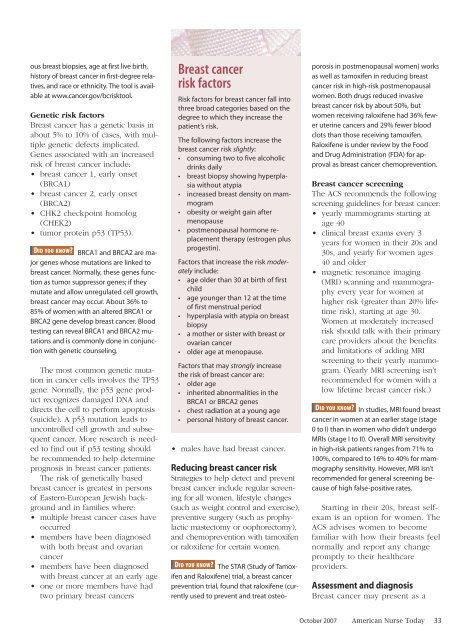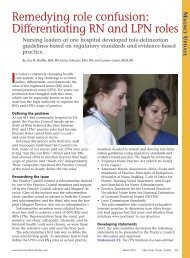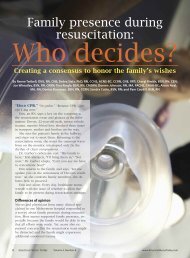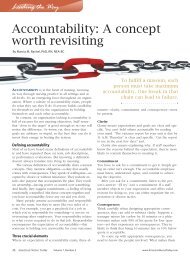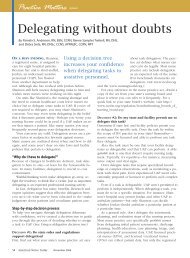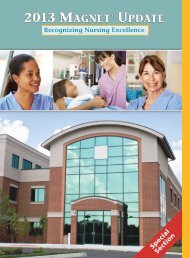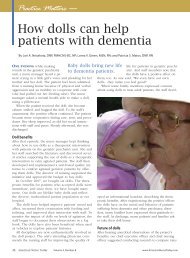Breast cancer risk factors - American Nurse Today
Breast cancer risk factors - American Nurse Today
Breast cancer risk factors - American Nurse Today
You also want an ePaper? Increase the reach of your titles
YUMPU automatically turns print PDFs into web optimized ePapers that Google loves.
ous breast biopsies, age at first live birth,<br />
history of breast <strong>cancer</strong> in first-degree relatives,<br />
and race or ethnicity. The tool is available<br />
at www.<strong>cancer</strong>.gov/bc<strong>risk</strong>tool.<br />
Genetic <strong>risk</strong> <strong>factors</strong><br />
<strong>Breast</strong> <strong>cancer</strong> has a genetic basis in<br />
about 5% to 10% of cases, with multiple<br />
genetic defects implicated.<br />
Genes associated with an increased<br />
<strong>risk</strong> of breast <strong>cancer</strong> include:<br />
• breast <strong>cancer</strong> 1, early onset<br />
(BRCA1)<br />
• breast <strong>cancer</strong> 2, early onset<br />
(BRCA2)<br />
• CHK2 checkpoint homolog<br />
(CHEK2)<br />
• tumor protein p53 (TP53).<br />
DID YOU KNOW BRCA1 and BRCA2 are major<br />
genes whose mutations are linked to<br />
breast <strong>cancer</strong>. Normally, these genes function<br />
as tumor suppressor genes; if they<br />
mutate and allow unregulated cell growth,<br />
breast <strong>cancer</strong> may occur. About 36% to<br />
85% of women with an altered BRCA1 or<br />
BRCA2 gene develop breast <strong>cancer</strong>. Blood<br />
testing can reveal BRCA1 and BRCA2 mutations<br />
and is commonly done in conjunction<br />
with genetic counseling.<br />
The most common genetic mutation<br />
in <strong>cancer</strong> cells involves the TP53<br />
gene. Normally, the p53 gene product<br />
recognizes damaged DNA and<br />
directs the cell to perform apoptosis<br />
(suicide). A p53 mutation leads to<br />
uncontrolled cell growth and subsequent<br />
<strong>cancer</strong>. More research is needed<br />
to find out if p53 testing should<br />
be recommended to help determine<br />
prognosis in breast <strong>cancer</strong> patients.<br />
The <strong>risk</strong> of genetically based<br />
breast <strong>cancer</strong> is greatest in persons<br />
of Eastern-European Jewish background<br />
and in families where:<br />
• multiple breast <strong>cancer</strong> cases have<br />
occurred<br />
• members have been diagnosed<br />
with both breast and ovarian<br />
<strong>cancer</strong><br />
• members have been diagnosed<br />
with breast <strong>cancer</strong> at an early age<br />
• one or more members have had<br />
two primary breast <strong>cancer</strong>s<br />
<strong>Breast</strong> <strong>cancer</strong><br />
<strong>risk</strong> <strong>factors</strong><br />
Risk <strong>factors</strong> for breast <strong>cancer</strong> fall into<br />
three broad categories based on the<br />
degree to which they increase the<br />
patient’s <strong>risk</strong>.<br />
The following <strong>factors</strong> increase the<br />
breast <strong>cancer</strong> <strong>risk</strong> slightly:<br />
• consuming two to five alcoholic<br />
drinks daily<br />
• breast biopsy showing hyperplasia<br />
without atypia<br />
• increased breast density on mammogram<br />
• obesity or weight gain after<br />
menopause<br />
• postmenopausal hormone replacement<br />
therapy (estrogen plus<br />
progestin).<br />
Factors that increase the <strong>risk</strong> moderately<br />
include:<br />
• age older than 30 at birth of first<br />
child<br />
• age younger than 12 at the time<br />
of first menstrual period<br />
• hyperplasia with atypia on breast<br />
biopsy<br />
• a mother or sister with breast or<br />
ovarian <strong>cancer</strong><br />
• older age at menopause.<br />
Factors that may strongly increase<br />
the <strong>risk</strong> of breast <strong>cancer</strong> are:<br />
• older age<br />
• inherited abnormalities in the<br />
BRCA1 or BRCA2 genes<br />
• chest radiation at a young age<br />
• personal history of breast <strong>cancer</strong>.<br />
• males have had breast <strong>cancer</strong>.<br />
Reducing breast <strong>cancer</strong> <strong>risk</strong><br />
Strategies to help detect and prevent<br />
breast <strong>cancer</strong> include regular screening<br />
for all women, lifestyle changes<br />
(such as weight control and exercise),<br />
preventive surgery (such as prophylactic<br />
mastectomy or oophorectomy),<br />
and chemoprevention with tamoxifen<br />
or raloxifene for certain women.<br />
DID YOU KNOW The STAR (Study of Tamoxifen<br />
and Raloxifene) trial, a breast <strong>cancer</strong><br />
prevention trial, found that raloxifene (currently<br />
used to prevent and treat osteoporosis<br />
in postmenopausal women) works<br />
as well as tamoxifen in reducing breast<br />
<strong>cancer</strong> <strong>risk</strong> in high-<strong>risk</strong> postmenopausal<br />
women. Both drugs reduced invasive<br />
breast <strong>cancer</strong> <strong>risk</strong> by about 50%, but<br />
women receiving raloxifene had 36% fewer<br />
uterine <strong>cancer</strong>s and 29% fewer blood<br />
clots than those receiving tamoxifen.<br />
Raloxifene is under review by the Food<br />
and Drug Administration (FDA) for approval<br />
as breast <strong>cancer</strong> chemoprevention.<br />
<strong>Breast</strong> <strong>cancer</strong> screening<br />
The ACS recommends the following<br />
screening guidelines for breast <strong>cancer</strong>:<br />
• yearly mammograms starting at<br />
age 40<br />
• clinical breast exams every 3<br />
years for women in their 20s and<br />
30s, and yearly for women ages<br />
40 and older<br />
• magnetic resonance imaging<br />
(MRI) scanning and mammography<br />
every year for women at<br />
higher <strong>risk</strong> (greater than 20% lifetime<br />
<strong>risk</strong>), starting at age 30.<br />
Women at moderately increased<br />
<strong>risk</strong> should talk with their primary<br />
care providers about the benefits<br />
and limitations of adding MRI<br />
screening to their yearly mammogram.<br />
(Yearly MRI screening isn’t<br />
recommended for women with a<br />
low lifetime breast <strong>cancer</strong> <strong>risk</strong>.)<br />
DID YOU KNOW In studies, MRI found breast<br />
<strong>cancer</strong> in women at an earlier stage (stage<br />
0 to I) than in women who didn’t undergo<br />
MRIs (stage I to II). Overall MRI sensitivity<br />
in high-<strong>risk</strong> patients ranges from 71% to<br />
100%, compared to 16% to 40% for mammography<br />
sensitivity. However, MRI isn’t<br />
recommended for general screening because<br />
of high false-positive rates.<br />
Starting in their 20s, breast selfexam<br />
is an option for women. The<br />
ACS advises women to become<br />
familiar with how their breasts feel<br />
normally and report any change<br />
promptly to their healthcare<br />
providers.<br />
Assessment and diagnosis<br />
<strong>Breast</strong> <strong>cancer</strong> may present as a<br />
October 2007 <strong>American</strong> <strong>Nurse</strong> <strong>Today</strong> 33


